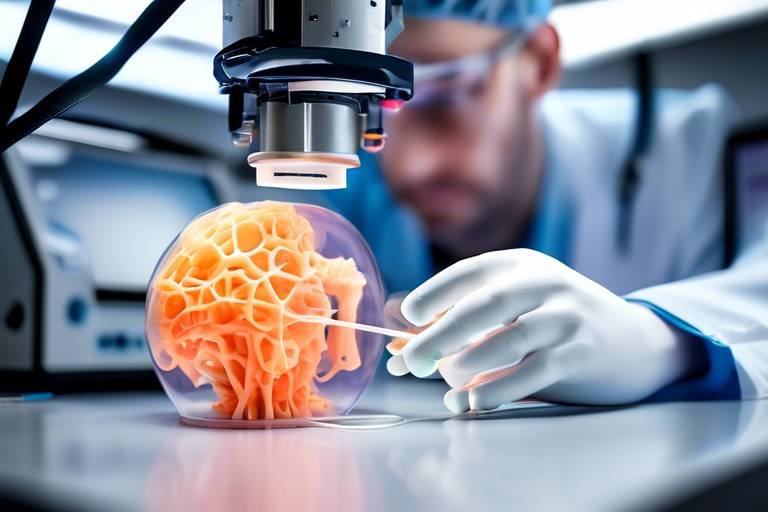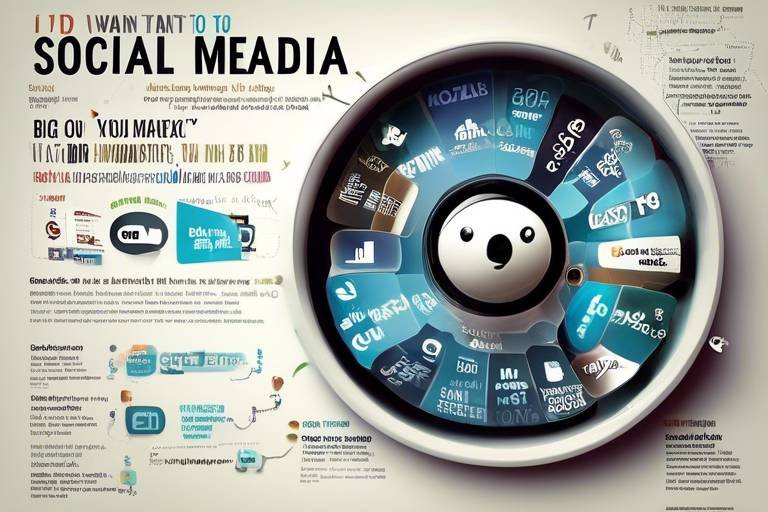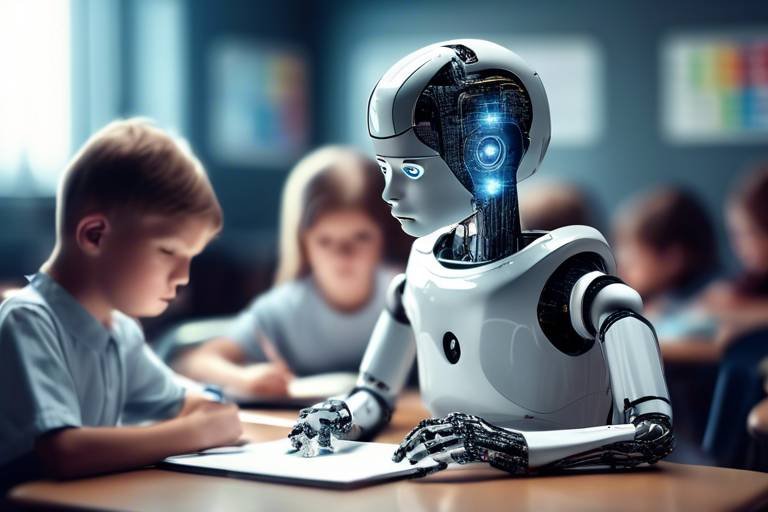3D Printing: The Future of Manufacturing
Welcome to the future of manufacturing, where 3D printing is not just a trend but a revolution that is reshaping the way we think about production. Imagine a world where you can create complex designs at the click of a button, where customization is the norm, and where the waste produced in traditional manufacturing is significantly reduced. This is the promise of 3D printing, a technology that has evolved from a niche application to a mainstream manufacturing process. In this article, we will dive into the transformative impact of 3D printing on various industries, explore its benefits and challenges, and speculate on what the future holds for this groundbreaking technology.
The journey of 3D printing began in the early 1980s with the invention of stereolithography by Chuck Hull. This revolutionary technology allowed for the creation of three-dimensional objects by layering materials, a concept that seemed like science fiction at the time. Fast forward to today, and we have witnessed significant advancements, including selective laser sintering (SLS), fused deposition modeling (FDM), and more recently, bioprinting. Each of these milestones has contributed to the versatility and efficiency of 3D printing, making it an indispensable tool in modern manufacturing.
3D printing is making waves across numerous sectors, proving its versatility and innovative applications. From healthcare to aerospace, the possibilities are endless. In the healthcare sector, for instance, 3D printing is used to create customized prosthetics and implants, ensuring a perfect fit for each patient. Meanwhile, in aerospace, manufacturers are leveraging this technology to produce lightweight components that enhance fuel efficiency and performance. The automotive industry is also on board, utilizing 3D printing for rapid prototyping and parts manufacturing, significantly speeding up the production process.
In healthcare, 3D printing is nothing short of a game-changer. It enables the production of patient-specific solutions that improve outcomes and enhance the quality of care. The use of 3D printing in healthcare can be categorized into two main areas:
- Prosthetics and Implants: 3D printing allows for the creation of personalized prosthetics that are tailored to the unique anatomy of each patient. This customization not only improves comfort but also enhances functionality, leading to better overall satisfaction for users.
- Bioprinting and Tissue Engineering: The potential of bioprinting is vast, with the ability to create living tissues and even organs. This technology is revolutionizing transplant medicine and regenerative therapies, offering hope to those in need of organ transplants.
The aerospace and automotive industries are at the forefront of adopting 3D printing technologies. By enabling the production of lightweight designs, manufacturers can significantly reduce fuel consumption and emissions. Rapid prototyping has also become a reality, allowing companies to test and refine their designs faster than ever before. This agility in production not only saves time but also reduces costs, making it an attractive option for manufacturers striving to stay competitive.
So, what makes 3D printing so appealing? Let's break down the key benefits:
- Cost Efficiency: Traditional manufacturing often involves significant material waste and high production costs. 3D printing minimizes waste by using only the necessary amount of material, leading to substantial cost savings.
- Design Flexibility: The ability to create complex geometries and custom designs is one of the standout features of 3D printing. Unlike traditional methods, which can be limited by tooling and setup, 3D printing allows for unparalleled creativity and innovation.
- Sustainability: With the growing emphasis on sustainability, 3D printing offers a more eco-friendly alternative to conventional manufacturing by reducing waste and enabling localized production.
Despite its many advantages, 3D printing is not without its challenges. Some of the key issues include:
- Material Constraints: While the range of materials available for 3D printing is expanding, there are still limitations. Ongoing research is critical to develop new materials that can withstand the demands of various applications.
- Regulatory and Quality Control Issues: As 3D printing becomes more prevalent, navigating the regulatory landscape and ensuring quality control will be paramount. Manufacturers must adhere to strict standards to maintain safety and efficacy.
Looking ahead, the future of 3D printing is bright. Emerging technologies, such as multi-material printing and faster production methods, are set to enhance its capabilities. Furthermore, the integration of 3D printing with Industry 4.0 initiatives, including automation and data analytics, will create smarter manufacturing processes. As we continue to explore the potential of this technology, we can expect to see even more innovative applications that will further revolutionize the manufacturing landscape.
Q: What materials can be used in 3D printing?
A: 3D printing can utilize a variety of materials, including plastics, metals, ceramics, and even biological materials for bioprinting.
Q: How does 3D printing reduce waste?
A: 3D printing creates objects layer by layer, using only the necessary amount of material, which significantly reduces waste compared to traditional subtractive manufacturing methods.
Q: What industries are benefiting from 3D printing?
A: Industries such as healthcare, aerospace, automotive, and consumer goods are all leveraging 3D printing for its versatility and efficiency.
Q: Is 3D printing environmentally friendly?
A: Yes, 3D printing can be more sustainable than traditional manufacturing by reducing material waste and allowing for localized production, which lowers transportation emissions.

The Evolution of 3D Printing
The story of 3D printing is nothing short of remarkable, tracing its roots back to the early 1980s when a visionary named Chuck Hull invented the first stereolithography machine. This groundbreaking technology allowed for the creation of three-dimensional objects from digital files, effectively laying the foundation for what we now know as additive manufacturing. Fast forward to today, and 3D printing has evolved into a multifaceted industry that touches nearly every sector imaginable.
In the years that followed Hull's invention, several key milestones marked the evolution of 3D printing technologies. The introduction of Selective Laser Sintering (SLS) in the late 1980s and Fused Deposition Modeling (FDM) in the early 1990s expanded the possibilities of 3D printing, making it accessible for various applications. These technologies paved the way for the democratization of 3D printing, as they became more affordable and user-friendly, allowing hobbyists and small businesses to join the revolution.
As we moved into the 2000s, the landscape of 3D printing began to shift dramatically, driven by advancements in materials science and software development. The introduction of new materials, such as bio-compatible plastics and metals, opened doors to industries like healthcare and aerospace. This period also saw the rise of open-source 3D printing communities, which fostered innovation and collaboration among enthusiasts, engineers, and designers alike.
By the 2010s, 3D printing had transitioned from a niche technology to a mainstream manufacturing process. Major companies began to invest heavily in 3D printing, recognizing its potential to streamline production and reduce costs. The emergence of desktop 3D printers made it possible for anyone to create prototypes and products right from their home or office, further accelerating the adoption of this technology. Today, we see 3D printing not just as a tool for prototyping but as a legitimate means of production for end-use products.
To give you a clearer picture of this evolution, here’s a brief timeline highlighting some of the significant developments in 3D printing:
| Year | Milestone |
|---|---|
| 1981 | Chuck Hull invents stereolithography |
| 1987 | First commercial 3D printer, SLA-1, is launched |
| 1992 | Introduction of Selective Laser Sintering (SLS) |
| 1999 | Fused Deposition Modeling (FDM) becomes popular |
| 2008 | First open-source 3D printer is released |
| 2012 | 3D printing gains mainstream attention with the launch of MakerBot |
| 2020 | 3D printing used in response to COVID-19 for PPE production |
As we look to the future, it’s clear that 3D printing is poised to continue its evolution. With ongoing research into new materials, faster production methods, and integration with Industry 4.0 technologies, the possibilities are virtually limitless. The journey of 3D printing is a testament to human ingenuity and innovation, and it’s exciting to think about where this technology will take us next.
- What is 3D printing? 3D printing, also known as additive manufacturing, is a process of creating three-dimensional objects from a digital file by adding material layer by layer.
- What industries use 3D printing? 3D printing is utilized in various industries, including healthcare, aerospace, automotive, and consumer goods.
- What are the benefits of 3D printing? Some benefits include cost efficiency, design flexibility, and sustainability, as it often reduces material waste.
- What are the challenges of 3D printing? Challenges include material limitations, regulatory hurdles, and the need for skilled operators to manage advanced machines.

Applications in Various Industries
3D printing has emerged as a game-changer across a myriad of industries, fundamentally altering how products are designed, manufactured, and delivered. This technology is not just a novelty; it has found its way into sectors that range from healthcare to aerospace, demonstrating its versatility and innovative potential. Imagine being able to create complex structures and components in a fraction of the time it would take using traditional manufacturing methods. That's the power of 3D printing!
In the healthcare sector, 3D printing is revolutionizing patient care. Surgeons can now use customized surgical models created from a patient's own scans, allowing for better planning and execution of complex procedures. This not only enhances precision but also significantly reduces the risks involved. Moreover, the development of personalized prosthetics and implants has transformed the lives of countless individuals, offering them improved comfort and functionality. The ability to tailor these devices to the specific needs of each patient is a monumental leap forward in medical technology.
Moving on to the aerospace industry, 3D printing is making waves by enabling the production of lightweight components that enhance fuel efficiency. Traditional manufacturing often involves subtractive processes that can waste significant material; however, with 3D printing, components can be built layer by layer, minimizing waste. This not only reduces costs but also leads to faster prototyping and production times. For instance, companies like Boeing are utilizing 3D printing to produce intricate parts that were once too complex to manufacture using conventional methods.
In the automotive field, manufacturers are leveraging 3D printing for rapid prototyping, allowing them to test designs before committing to mass production. This capability not only speeds up the development process but also fosters innovation, as designers can experiment with new ideas without the financial burden of traditional prototyping methods. Additionally, the ability to print spare parts on-demand is transforming supply chain logistics, reducing the need for large inventories.
Even in the realm of consumer goods, 3D printing is gaining traction. From customized jewelry to home décor, the ability to create unique, personalized items is appealing to consumers who crave individuality. This shift towards customization is not just a trend; it reflects a broader movement towards sustainable manufacturing practices, as 3D printing allows for localized production, reducing shipping costs and carbon footprints.
To summarize, the applications of 3D printing are as diverse as they are impactful. Whether it's enhancing surgical outcomes, revolutionizing aerospace design, or allowing automotive companies to innovate faster, the potential is enormous. As technology continues to advance, we can expect 3D printing to penetrate even more industries, reshaping the landscape of manufacturing as we know it.
- What industries benefit the most from 3D printing?
Industries such as healthcare, aerospace, automotive, and consumer goods are among the most significantly impacted by 3D printing technology.
- How does 3D printing improve healthcare?
3D printing allows for the customization of medical devices and surgical models, improving patient outcomes and reducing risks during procedures.
- Can 3D printing reduce manufacturing costs?
Yes, it minimizes material waste and allows for faster prototyping, which can significantly lower production costs.
- What are the limitations of 3D printing?
Current limitations include material constraints, regulatory hurdles, and the need for skilled labor to operate advanced machines.

Healthcare Innovations
In the realm of healthcare, 3D printing is nothing short of a game changer. Imagine a world where medical solutions are tailor-made for each individual, where prosthetics fit like a glove, and organs can be printed on demand. This is not science fiction; it’s the reality brought forth by the revolutionary technology of 3D printing. The ability to create custom solutions enhances patient care and opens up a plethora of possibilities that were once confined to the realm of imagination.
One of the most remarkable applications of 3D printing in healthcare is in the creation of prosthetics and implants. Traditional methods of manufacturing prosthetic limbs can be time-consuming and costly, often resulting in products that do not perfectly fit the patient. With 3D printing, however, medical professionals can design and produce personalized prosthetics that are not only more comfortable but also more functional. This technology allows for rapid prototyping, meaning that adjustments can be made quickly based on a patient’s unique anatomy. The result? A prosthetic limb that feels like a natural extension of the body.
Moreover, the potential of bioprinting is equally astounding. Imagine being able to print living tissues and even organs! Bioprinting uses a similar process to traditional 3D printing but incorporates biological materials, such as cells and growth factors. This technology is paving the way for revolutionary advancements in transplant medicine and regenerative therapies. For instance, researchers are exploring ways to print skin for burn victims or even organs for those awaiting transplants. This could significantly reduce the waiting time and the risk of organ rejection.
As we delve deeper into the applications of 3D printing in healthcare, it’s crucial to highlight its role in enhancing surgical planning. Surgeons can create precise anatomical models of a patient’s body using 3D printing. These models serve as invaluable tools for pre-surgical planning, allowing doctors to rehearse complex procedures. This not only boosts the surgeons' confidence but also enhances the overall success rate of surgeries. Imagine walking into a surgical room where the team has already practiced your procedure using a 3D model of your own anatomy!
In summary, the innovations brought about by 3D printing in healthcare are reshaping the way we think about medical treatment. From personalized prosthetics to the potential for bioprinting organs, the possibilities are limitless. As technology continues to evolve, we can expect even more groundbreaking advancements that will enhance patient care and improve outcomes.
- What is 3D printing in healthcare?
3D printing in healthcare refers to the process of using 3D printing technology to create medical devices, prosthetics, implants, and even tissues and organs tailored to individual patients. - How does 3D printing improve prosthetics?
3D printing allows for the creation of customized prosthetics that fit better and are more comfortable for the patient, reducing the time and cost associated with traditional methods. - What is bioprinting?
Bioprinting is a specialized form of 3D printing that uses biological materials to create living tissues and organs, potentially revolutionizing transplant medicine. - Can 3D printing be used for surgical planning?
Yes, surgeons can create accurate anatomical models of patients using 3D printing to rehearse complex procedures, thereby improving the chances of successful outcomes.

Prosthetics and Implants
In the realm of healthcare, 3D printing is making waves, particularly in the production of . Imagine a world where a patient’s unique anatomy is perfectly matched by their prosthetic limb, resulting in enhanced comfort and functionality. This is not just a dream; it’s a reality made possible by advanced 3D printing technologies. Traditional prosthetics often involve a one-size-fits-all approach, which can lead to discomfort and reduced mobility. However, with 3D printing, customization is at the forefront, allowing for tailored solutions that meet individual needs.
One of the most significant advantages of 3D-printed prosthetics is the speed of production. Traditional manufacturing methods can take weeks or even months to produce a prosthetic limb. In contrast, 3D printing can create a fully functional limb in a matter of days. This rapid turnaround is crucial for patients who are eager to regain mobility and independence. Additionally, the ability to quickly iterate designs means that prosthetics can be refined based on real-world feedback, leading to continuous improvements in comfort and performance.
Furthermore, the cost of 3D-printed prosthetics is often lower than that of traditionally manufactured options. By minimizing material waste and reducing labor costs, manufacturers can pass savings onto patients. This affordability opens doors for individuals who may have previously been unable to afford high-quality prosthetics. In fact, studies have shown that the average cost of a 3D-printed prosthetic limb can be significantly lower than its traditional counterpart, making advanced prosthetic technology accessible to a broader audience.
Another exciting development in this field is the use of advanced materials in 3D printing. Biocompatible materials can be utilized to create implants that not only fit perfectly but also integrate seamlessly with the patient’s body. This is particularly important for implants that need to be durable and withstand the rigors of everyday use. The future of prosthetics and implants looks promising, with ongoing research aimed at developing even more sophisticated materials that can mimic the properties of human tissue.
However, it’s essential to acknowledge the challenges that come with these innovations. While 3D printing offers incredible customization, there are still hurdles to overcome in terms of regulatory approval and quality control. Ensuring that each prosthetic or implant meets stringent safety standards is crucial, as even minor flaws can lead to significant health risks for patients. As the technology continues to evolve, so too must the regulations governing its use to ensure that patients receive the highest quality care.
In summary, the integration of 3D printing into the production of prosthetics and implants is revolutionizing patient care. With the ability to create customized, affordable, and high-quality solutions, this technology is not just improving lives; it's transforming them. As we look to the future, the potential for 3D printing in healthcare is boundless, promising innovations that could redefine what is possible in prosthetic and implant technology.
- What are the main benefits of 3D-printed prosthetics?
3D-printed prosthetics offer customization, reduced production time, and lower costs compared to traditional options. - How does 3D printing improve the comfort of prosthetics?
By creating personalized designs that fit the unique anatomy of each patient, 3D printing enhances comfort and functionality. - Are 3D-printed implants safe?
Yes, but they must meet strict regulatory standards to ensure safety and quality. - What materials are used in 3D printing for prosthetics?
Biocompatible materials are commonly used to ensure that the prosthetics and implants are safe for the body.

Bioprinting and Tissue Engineering
Bioprinting and tissue engineering represent a revolutionary leap in the realm of healthcare, merging the worlds of biology and engineering to create living tissues and organs. Imagine a world where damaged tissues can be replaced with lab-grown alternatives tailored specifically for each patient. This is not just a fantasy; it is becoming a reality thanks to advancements in 3D printing technology. Bioprinting involves the precise layering of bio-inks, which are composed of living cells and biomaterials, to construct complex tissue structures. This process is akin to a chef layering ingredients to create a gourmet dish, where each layer must be perfectly placed to ensure the final product is not only functional but also viable.
The potential applications of bioprinting are vast. For instance, researchers are exploring how to print skin for burn victims, cartilage for joint repair, and even organs for transplants. The ability to customize these tissues means that they can be designed to match the patient's unique biological makeup, significantly reducing the risk of rejection. The implications for transplant medicine are enormous; currently, many patients die waiting for organ transplants. Bioprinting could help alleviate this shortage by providing a sustainable source of organs that are created from the patient's own cells.
However, the journey towards fully functional bioprinted organs is fraught with challenges. Scientists must ensure that the printed tissues can not only survive but also integrate with the body’s existing systems. This involves complex interactions between cells, blood vessels, and the surrounding tissues. Furthermore, the regulatory landscape is still catching up with these innovations, as there are strict guidelines that must be followed to ensure patient safety.
As research continues, we can expect to see a transformation in how we approach healthcare. The idea of personalized medicine is becoming more tangible, and bioprinting stands at the forefront of this movement. Just as the invention of the printing press revolutionized the dissemination of information, bioprinting has the potential to revolutionize medical treatments, making them more effective and accessible. The future of tissue engineering is bright, and with continued investment and innovation, we may soon witness the dawn of a new era in regenerative medicine.
- What is bioprinting? Bioprinting is a 3D printing technology that uses living cells and biomaterials to create tissues and organs.
- How can bioprinting benefit patients? It allows for the creation of customized tissues and organs, reducing the risk of rejection and addressing organ shortages.
- What are the challenges of bioprinting? Challenges include ensuring tissue viability, integration with the body, and navigating regulatory hurdles.
- What is the future of bioprinting? The future looks promising with advancements in technology that could lead to fully functional printed organs for transplantation.

Aerospace and Automotive Advancements
The impact of 3D printing in the aerospace and automotive industries is nothing short of revolutionary. Imagine a world where parts can be produced on-demand, reducing lead times from weeks to mere hours. This is not science fiction; it’s the reality brought forth by 3D printing technology. In aerospace, where weight and efficiency are paramount, manufacturers are leveraging additive manufacturing to create lightweight components that significantly enhance fuel efficiency. For example, Boeing has been at the forefront, utilizing 3D printing to produce critical parts for their aircraft, leading to a reduction in both weight and cost.
In the automotive sector, companies like Ford and BMW are embracing 3D printing to streamline their production processes. They can now produce complex geometries that were previously impossible with traditional manufacturing methods. This capability not only allows for greater design flexibility but also enables rapid prototyping. Engineers can quickly iterate on designs, test them, and make adjustments without the need for extensive tooling, which can be both time-consuming and expensive.
One of the standout examples of 3D printing in automotive manufacturing is the production of customized components. With 3D printing, manufacturers can create parts tailored specifically to individual vehicles or even specific customer preferences. This level of customization not only enhances the consumer experience but also reduces inventory costs since manufacturers can print parts as needed rather than maintaining large stocks of various components.
Moreover, the integration of 3D printing into the supply chain is transforming how these industries operate. By adopting a just-in-time manufacturing approach, companies can minimize waste and respond quickly to changing consumer demands. This agility is crucial in today’s fast-paced market, where consumer preferences can shift overnight.
However, it's essential to acknowledge that with great innovation comes challenges. The aerospace and automotive industries face hurdles such as material limitations and regulatory compliance. While 3D printing offers exciting possibilities, ensuring that printed parts meet stringent safety and quality standards is a top priority. Companies are investing heavily in research to develop new materials that can withstand the rigors of flight and road use, ensuring that 3D printed components are both safe and reliable.
In conclusion, the advancements in 3D printing technology are reshaping the landscape of aerospace and automotive manufacturing. As companies continue to explore and exploit the potential of this technology, we can expect to see even more innovative applications that will drive efficiency, customization, and sustainability in these critical industries.
- What is 3D printing?
3D printing, or additive manufacturing, is a process of creating three-dimensional objects from a digital file by layering materials.
- How is 3D printing used in aerospace?
In aerospace, 3D printing is used to create lightweight components, reduce production time, and enable rapid prototyping of parts.
- What are the benefits of 3D printing in automotive manufacturing?
Benefits include cost reduction, design flexibility, and the ability to produce customized parts on demand.
- What challenges does 3D printing face in these industries?
Challenges include material limitations, regulatory hurdles, and ensuring quality control in production.

Benefits of 3D Printing
When it comes to modern manufacturing, 3D printing is like the Swiss Army knife of production techniques—versatile, efficient, and downright revolutionary. This technology is not just a passing trend; it’s reshaping the way we think about creating products. From reducing costs to enhancing design flexibility, the benefits of 3D printing are numerous and impactful. Let’s dive into some of the most significant advantages that are making waves across various industries.
One of the standout benefits of 3D printing is its cost efficiency. Traditional manufacturing processes often involve significant upfront costs for tooling and materials. In contrast, 3D printing allows manufacturers to create items layer by layer, meaning they can produce complex designs without the need for expensive molds or tooling. This not only helps in reducing material waste—a common issue in traditional manufacturing—but also leads to lower production costs overall. According to recent studies, companies that have adopted 3D printing have seen a reduction in production costs by up to 70%!
Furthermore, the design flexibility that 3D printing offers is unparalleled. Imagine being able to create intricate geometries and custom designs that traditional methods simply can't handle. With 3D printing, the limitations of conventional manufacturing are thrown out the window. Designers can experiment with shapes, sizes, and structures that were once deemed impossible. This opens up a world of possibilities, allowing for innovations that can lead to better-performing products. For instance, in the aerospace industry, engineers can design parts that are not only lighter but also stronger, enhancing fuel efficiency and performance.
Another critical aspect of 3D printing is its positive impact on sustainability. As the world grapples with environmental challenges, manufacturers are under pressure to adopt greener practices. 3D printing contributes to sustainability by minimizing waste and allowing for the use of recycled materials. Unlike traditional methods that often lead to excess material being discarded, 3D printing utilizes only the material needed for production. This not only conserves resources but also aligns with the growing demand for eco-friendly manufacturing practices.
However, the benefits of 3D printing extend beyond cost and design. The technology also facilitates rapid prototyping, enabling companies to bring products to market faster than ever before. In today's fast-paced business environment, speed is crucial. With 3D printing, prototypes can be produced in a matter of hours rather than weeks, allowing for quicker testing and iteration. This agility means that businesses can respond to market demands and consumer feedback with remarkable speed, ultimately leading to better products and increased customer satisfaction.
To illustrate these benefits more clearly, here’s a table summarizing the key advantages of 3D printing:
| Benefit | Description |
|---|---|
| Cost Efficiency | Reduces material waste and production costs significantly. |
| Design Flexibility | Enables intricate and customized designs that traditional methods can't achieve. |
| Sustainability | Minimizes waste and allows for the use of recycled materials. |
| Rapid Prototyping | Speeds up the product development process, allowing for quicker market entry. |
In conclusion, the benefits of 3D printing are reshaping the manufacturing landscape, making it more efficient, sustainable, and innovative. As industries continue to explore the endless possibilities of this technology, we can expect to see even more groundbreaking applications in the near future. So, whether you're a manufacturer looking to streamline your processes or a consumer eager for customized products, 3D printing is undoubtedly a game-changer worth watching.
- What industries can benefit from 3D printing? Virtually every sector, including healthcare, aerospace, automotive, and consumer goods, can leverage 3D printing for various applications.
- Is 3D printing environmentally friendly? Yes, 3D printing reduces material waste and allows for the use of recycled materials, making it a more sustainable option compared to traditional manufacturing.
- How does 3D printing improve product design? It allows for complex geometries and custom designs that traditional methods cannot achieve, fostering innovation and creativity.

Cost Efficiency
When it comes to manufacturing, the bottom line often dictates the choices businesses make. This is where 3D printing shines like a beacon of hope! Imagine a world where production costs are slashed, and waste is minimized—sounds like a dream, right? Well, with 3D printing, that dream is becoming a reality. One of the most significant advantages of this technology is its ability to reduce material waste and lower production costs. Traditional manufacturing processes often involve cutting, molding, or subtracting material, which can lead to substantial waste. In contrast, 3D printing is an additive process, meaning it builds objects layer by layer, using only the necessary amount of material.
Consider this: in traditional manufacturing, if you're creating a complex part, you might have to start with a large block of material and carve out the desired shape. This not only wastes material but also consumes time and labor. With 3D printing, you can produce that same part directly from a digital model, significantly cutting down on excess material. This efficiency translates into cost savings that can be reinvested into other areas of the business.
Moreover, the initial investment in 3D printing technology can be offset by the long-term savings it offers. While the price of 3D printers has decreased over the years, the cost of traditional manufacturing equipment can be staggering. For small businesses or startups, this can be a game changer. They can now produce high-quality prototypes and products without the hefty price tag of traditional manufacturing setups.
Another aspect to consider is the speed of production. 3D printing allows for rapid prototyping, which means businesses can iterate designs quickly. This agility not only saves time but also reduces costs associated with lengthy production cycles. Instead of waiting weeks for a part to be manufactured, businesses can produce it in a matter of hours or days. This speed can be crucial in industries where time-to-market is a competitive advantage.
To illustrate the cost efficiency of 3D printing, let’s look at a simple comparison:
| Aspect | Traditional Manufacturing | 3D Printing |
|---|---|---|
| Material Waste | High | Low |
| Production Time | Weeks | Hours/Days |
| Initial Investment | High | Lower |
| Design Complexity | Limited | Unlimited |
As you can see, the advantages of 3D printing extend far beyond just cost savings. It opens up a world of possibilities for innovation and creativity that traditional manufacturing methods simply can't match. In a market that is constantly evolving, being able to adapt quickly and efficiently is essential for survival. 3D printing not only meets these demands but does so in a way that is financially beneficial.
In conclusion, embracing 3D printing technology can lead to significant cost efficiencies that are hard to ignore. As businesses look to streamline operations and cut costs, 3D printing stands out as a viable solution that promises not just savings, but also the ability to innovate and stay competitive in an ever-changing landscape.
- What is the main advantage of 3D printing in terms of cost?
3D printing reduces material waste and lowers production costs by using only the necessary amount of material. - How does 3D printing speed up production?
It allows for rapid prototyping, enabling businesses to create designs quickly without lengthy production cycles. - Is 3D printing suitable for small businesses?
Yes, it can be a cost-effective solution for small businesses looking to produce high-quality products without significant initial investment.

Design Flexibility
One of the most exciting aspects of 3D printing is its unparalleled . Imagine being able to create intricate designs that were once deemed impossible with traditional manufacturing methods. This technology allows for the production of complex geometries, enabling designers and engineers to push the boundaries of creativity and innovation. With 3D printing, you can easily modify designs without the need for expensive tooling changes, making it a game-changer in product development.
For instance, consider the aerospace industry, where every gram counts. 3D printing facilitates the creation of lightweight components that maintain strength and durability. This is achieved through the use of lattice structures and organic shapes that are impossible to fabricate using conventional methods. By leveraging this flexibility, manufacturers can significantly reduce the weight of aircraft, leading to improved fuel efficiency and reduced emissions.
Moreover, 3D printing opens the door to customization. Whether it's a unique piece of jewelry or a tailored medical implant, the ability to produce one-off items at a reasonable cost is a significant advantage. Customers today are looking for personalized products that reflect their individual tastes and needs. With 3D printing, businesses can offer bespoke solutions that enhance customer satisfaction and loyalty.
To illustrate this point, let's look at some examples of how different industries are utilizing design flexibility:
| Industry | Application | Benefits |
|---|---|---|
| Aerospace | Lightweight components | Improved fuel efficiency |
| Healthcare | Custom prosthetics | Enhanced comfort and functionality |
| Consumer Goods | Personalized products | Increased customer satisfaction |
This table highlights just a few of the many ways that 3D printing's design flexibility is making waves across various sectors. Additionally, the iterative nature of 3D printing means that designers can quickly prototype and test multiple variations of a product. This rapid prototyping capability not only accelerates the development process but also ensures that the final product is optimized for performance and usability.
However, it's important to note that with great flexibility comes the need for a solid understanding of design principles. Designers must be well-versed in the capabilities and limitations of 3D printing technologies to fully exploit its potential. As the technology continues to evolve, we can expect even greater advancements that will further enhance design flexibility, allowing for more intricate and efficient designs that meet the demands of an ever-changing market.
- What industries benefit most from 3D printing?
3D printing is revolutionizing several industries, including aerospace, healthcare, automotive, and consumer goods, by providing innovative solutions and customization. - How does 3D printing improve design flexibility?
3D printing allows for complex geometries and rapid prototyping, enabling designers to create intricate designs and modify them easily without significant costs. - Can 3D printing produce customized products?
Yes, 3D printing is ideal for creating personalized products tailored to individual customer preferences, enhancing satisfaction and loyalty.

Challenges and Limitations
As revolutionary as 3D printing is, it doesn't come without its fair share of challenges and limitations. Think of it like a shiny new car; while it has the potential to take you places you've never been, it also requires maintenance, fuel, and sometimes, a bit of know-how to operate effectively. One of the primary challenges facing the 3D printing industry is the material constraints. Currently, the range of materials that can be used for 3D printing is still somewhat limited. While we’ve seen significant advancements, many traditional materials like metals and certain plastics are still difficult to print with precision. This limitation can hinder the production of parts that require specific properties, such as strength, flexibility, or heat resistance.
Moreover, the regulatory landscape surrounding 3D printing remains murky. As the technology continues to evolve, so too do the regulations that govern its use. Manufacturers must navigate complex legal frameworks that vary by country and industry. This is particularly crucial in sectors like healthcare, where safety and efficacy are paramount. Without clear guidelines, companies might find themselves in a precarious position, risking compliance violations and potential legal repercussions.
Another significant hurdle is the need for skilled labor. While operating a 3D printer might seem straightforward, the reality is that it requires a level of expertise that many companies currently lack. Skilled technicians who understand the intricacies of 3D printing processes, materials, and design software are in high demand. The gap between the need for skilled labor and the available workforce can slow down the adoption of this transformative technology.
To illustrate these challenges more clearly, consider the table below, which summarizes the key challenges faced by the 3D printing industry:
| Challenge | Description |
|---|---|
| Material Constraints | Limited range of materials suitable for 3D printing, affecting the properties of printed parts. |
| Regulatory Issues | Complex legal frameworks that vary by industry and country, particularly in healthcare. |
| Skilled Labor Shortage | High demand for technicians with expertise in 3D printing processes and materials. |
In summary, while 3D printing holds incredible potential to revolutionize manufacturing, it is crucial to address these challenges head-on. As the industry evolves, overcoming these limitations will be key to unlocking the full potential of this technology and ensuring its widespread adoption across various sectors.
- What are the main materials used in 3D printing? The most common materials include plastics like PLA and ABS, metals like titanium and aluminum, and even bio-materials for healthcare applications.
- How does 3D printing affect traditional manufacturing? 3D printing can reduce costs and lead times, but it also requires traditional manufacturers to adapt to new technologies and processes.
- What industries are most impacted by 3D printing? Industries such as healthcare, aerospace, automotive, and consumer goods are seeing significant transformations due to 3D printing.

Material Constraints
When we talk about 3D printing, it's easy to get lost in the excitement of its possibilities. However, like any technology, it comes with its own set of challenges. One of the most significant hurdles is the that currently limit the scope of what can be produced. While the list of materials suitable for 3D printing is growing, it still pales in comparison to the vast array available for traditional manufacturing methods.
To put it simply, 3D printing is like a chef with a limited pantry—while they can whip up some incredible dishes with what's available, their creativity is stifled if they don't have the right ingredients. Most 3D printers primarily use plastics, metals, and ceramics. Each of these materials has its own set of properties, but they also come with limitations. For instance, while plastics can be molded into intricate shapes, they often lack the strength required for heavy-duty applications. On the other hand, metals, while strong, can be expensive and require specialized equipment to print effectively.
Moreover, the research and development in new materials is ongoing, but it takes time. Scientists are working tirelessly to create new filaments and powders that can withstand higher temperatures, offer better flexibility, or even possess unique properties like self-healing. For example, researchers are experimenting with bio-based materials that are not only sustainable but can also be used in medical applications. However, until these materials become commercially viable, many manufacturers are stuck with the same old options.
Another aspect to consider is the compatibility of materials with different printing technologies. Not all printers can handle every material, which can create bottlenecks in production. This limitation can lead to increased costs and longer lead times, as manufacturers may need to invest in multiple types of printers or compromise on the quality of their products.
| Material Type | Advantages | Limitations |
|---|---|---|
| Plastics | Cost-effective, versatile | Less durable, temperature-sensitive |
| Metals | High strength, heat resistance | Expensive, requires specialized equipment |
| Ceramics | Heat resistance, aesthetic appeal | Brittle, limited applications |
In conclusion, while the world of 3D printing is brimming with potential, the present a significant challenge that needs to be addressed. As the industry continues to evolve, overcoming these limitations will be crucial for unlocking the full capabilities of 3D printing technology. The future may hold exciting advancements in material science that could broaden the horizons of what we can create, but until then, manufacturers must navigate these constraints to find innovative solutions.
- What materials are commonly used in 3D printing? The most common materials include various plastics, metals, and ceramics.
- Are there any sustainable materials for 3D printing? Yes, researchers are developing bio-based materials that are eco-friendly and suitable for various applications.
- How do material constraints affect production costs? Limited material options can lead to increased production costs and longer lead times due to the need for specialized equipment or multiple printers.
- Is there ongoing research to overcome material constraints? Absolutely! Scientists and engineers are actively working on developing new materials with enhanced properties for 3D printing.

Regulatory and Quality Control Issues
As the world of 3D printing continues to evolve at a breakneck pace, it brings with it a host of regulatory and quality control challenges that cannot be overlooked. Imagine a scenario where a revolutionary new prosthetic limb is printed in a matter of hours, but how do we ensure that it meets the necessary safety and efficacy standards? This is where the complexities of regulation come into play. The absence of standardized guidelines for 3D printed products poses a significant risk not only to manufacturers but also to consumers who rely on these products for their health and safety.
One of the primary challenges is the diversity of materials used in 3D printing. Unlike traditional manufacturing, which often relies on a limited set of materials, 3D printing can utilize a vast array of substances, each with its own properties and potential risks. This variety complicates the regulatory landscape, as existing regulations may not adequately cover new materials or innovative applications. For instance, the use of biocompatible materials in medical applications requires rigorous testing to ensure they do not cause adverse reactions in patients.
Furthermore, the quality control processes for 3D printed products are still in their infancy. Traditional manufacturing has well-established protocols for quality assurance, but 3D printing often lacks the same level of scrutiny. This discrepancy can lead to inconsistencies in product quality, which is particularly concerning in critical sectors like healthcare and aerospace. To mitigate these risks, manufacturers must adopt comprehensive quality control measures, including:
- Regular audits of printing processes
- Material testing for each batch of products
- Post-production inspections to verify product integrity
Regulatory bodies are beginning to recognize these challenges, and some have started to develop guidelines specifically for 3D printing. However, the pace of innovation often outstrips the regulatory framework, creating a gap that can lead to potential safety issues. As such, it is crucial for industry stakeholders to engage with regulators to shape policies that are both flexible and effective in addressing the unique aspects of 3D printing.
In conclusion, while the potential of 3D printing is immense, the must be addressed to ensure that these innovations are safe and reliable. As the industry matures, it will be essential to establish a robust framework that not only fosters innovation but also protects consumers and maintains high standards of quality and safety. The future of 3D printing will depend significantly on how well we navigate these challenges.
- What are the main regulatory challenges in 3D printing?
The main challenges include the lack of standardized guidelines, diverse materials used, and the need for rigorous quality control processes.
- How does 3D printing impact product quality?
Inconsistencies in quality can arise due to the variability in printing processes and materials, making robust quality assurance measures essential.
- Are there any existing regulations for 3D printed medical devices?
Yes, some regulatory bodies are beginning to develop guidelines for 3D printed medical devices, but the framework is still evolving.

The Future of 3D Printing
The world of 3D printing is on the brink of an exhilarating transformation, one that promises to redefine not just manufacturing but the very fabric of our daily lives. As we gaze into the future, it's hard not to feel a sense of awe at the possibilities that lie ahead. Imagine a world where your next meal could be printed from a machine, or where you could create a custom part for your car with just a few clicks. The potential is staggering, and it's all driven by ongoing advancements in technology and materials.
One of the most exciting prospects is the development of emerging technologies that will enhance 3D printing capabilities. For instance, multi-material printing is gaining traction, allowing manufacturers to combine different materials in a single print. This innovation paves the way for creating more complex and functional products that can serve multiple purposes. Picture a smartphone case that not only protects your device but also has built-in features like a stand or a wallet. The possibilities are endless!
Moreover, the integration of 3D printing with Industry 4.0 is set to revolutionize the manufacturing landscape. Industry 4.0 emphasizes automation, data exchange, and smart technologies, and when combined with 3D printing, it opens up a realm of new opportunities. Imagine factories where machines communicate with each other in real-time, optimizing production processes and minimizing waste. Data analytics will play a crucial role here, enabling manufacturers to predict trends, manage inventory more efficiently, and enhance product quality.
As we look ahead, the advancements in materials will also be crucial. Currently, the range of materials available for 3D printing is somewhat limited, but researchers are tirelessly working to expand this range. Future developments may lead to the creation of stronger, lighter, and more sustainable materials that can withstand the rigors of various applications. This could include everything from biodegradable plastics to advanced composites that are ideal for aerospace engineering.
Of course, with great potential comes great responsibility. The challenges that the industry faces, such as regulatory hurdles and quality control issues, will need to be addressed. As 3D printing becomes more mainstream, ensuring that products meet safety and quality standards will be paramount. This will require collaboration between manufacturers, regulatory bodies, and technology developers to create a framework that supports innovation while protecting consumers.
In conclusion, the future of 3D printing is not just about creating objects; it's about creating a new way of thinking about manufacturing. As we embrace these technologies, we are stepping into a world where customization, efficiency, and sustainability are at the forefront. The journey is just beginning, and the excitement is palpable. Who knows? The next big breakthrough in 3D printing could be just around the corner, waiting to reshape our reality.
- What is 3D printing? - 3D printing is a manufacturing process that creates three-dimensional objects by layering materials based on digital models.
- What industries benefit from 3D printing? - Industries such as healthcare, aerospace, automotive, and consumer goods are leveraging 3D printing for its versatility and efficiency.
- What are the advantages of 3D printing? - Key advantages include cost efficiency, design flexibility, and the ability to create complex geometries that traditional manufacturing cannot achieve.
- What are the challenges faced by the 3D printing industry? - Challenges include material limitations, regulatory hurdles, and the need for skilled labor to operate advanced machines.

Emerging Technologies
The landscape of 3D printing is on the brink of a revolution, driven by that promise to enhance capabilities and broaden applications. As we look to the future, several innovations are poised to reshape how we think about manufacturing and design. One of the most exciting developments is multi-material printing, which allows for the simultaneous use of different materials in a single print job. This technology opens up a world of possibilities, enabling the creation of complex parts that combine the strengths of various materials, such as flexibility, durability, and thermal resistance, all in one go.
Another significant advancement is the emergence of faster production methods. Traditional 3D printing can be time-consuming, but new techniques are being developed to streamline the process. For instance, continuous liquid interface production (CLIP) technology utilizes a continuous flow of resin to create parts at remarkable speeds, significantly reducing the time from concept to prototype. This not only accelerates the design process but also enhances productivity, making 3D printing a more viable option for high-volume manufacturing.
Moreover, the integration of artificial intelligence (AI) into 3D printing processes is set to revolutionize how we approach design and production. AI can optimize designs for strength and weight, predict potential failures, and even automate the printing process. Imagine a world where machines can learn from previous prints, adjusting parameters on the fly to improve quality and efficiency. This level of sophistication could lead to a new era of smart manufacturing, where human intervention is minimized, and productivity is maximized.
As these technologies evolve, we may also see the rise of bio-printing that goes beyond simple tissue structures to potentially create entire organs. This could address the critical shortage of organ donors and transform the field of regenerative medicine. The implications are profound, as patient care could be revolutionized with custom-made organs that perfectly match the recipient's biological makeup.
In summary, the future of 3D printing is bright, filled with promise and potential. Emerging technologies like multi-material printing, rapid production methods, AI integration, and advanced bio-printing are not just innovations; they are the building blocks of a new manufacturing paradigm. As these technologies mature, they will undoubtedly unlock new opportunities and redefine the limits of what we can create.
- What is multi-material printing?
Multi-material printing refers to the process of using different materials in a single 3D print job, allowing for more complex and functional designs. - How does AI improve 3D printing?
AI can optimize designs, predict failures, and automate processes, leading to enhanced quality and efficiency in production. - What are the benefits of faster production methods?
Faster production methods reduce the time from design to prototype, increasing productivity and making 3D printing more feasible for high-volume manufacturing. - What is bio-printing?
Bio-printing is a technology that allows for the creation of living tissues and organs, which could revolutionize transplant medicine and regenerative therapies.

Integration with Industry 4.0
As we stand on the brink of a new era in manufacturing, the integration of 3D printing with Industry 4.0 is a game changer. Imagine a world where machines not only produce but also communicate, adapt, and optimize processes in real time. This is the essence of Industry 4.0, where smart factories leverage advanced technologies to create a more efficient production landscape. By incorporating 3D printing into this framework, manufacturers can unlock unprecedented levels of productivity and innovation.
So, what exactly does this integration look like? First off, it's all about data-driven decision making. 3D printers equipped with sensors can gather data on their performance, material usage, and even the environmental conditions during production. This information can be analyzed to predict maintenance needs, optimize printing parameters, and reduce downtime. In essence, these machines become intelligent entities that can self-regulate and improve over time.
Moreover, the synergy between 3D printing and Industry 4.0 fosters customization at an unprecedented scale. Manufacturers can utilize real-time data to adjust designs based on consumer preferences, leading to a more personalized product offering. For instance, in the automotive industry, companies can quickly adapt car parts to meet specific customer demands without the need for extensive retooling. This adaptability is crucial in a market that increasingly values personalization.
Another fascinating aspect is the potential for collaborative robots, or cobots, to work alongside 3D printers. These robots can assist in the printing process, handling tasks such as material loading and post-processing. By reducing the manual labor required, manufacturers can focus on more complex tasks that require human ingenuity. The collaboration between humans and machines can lead to a more harmonious and efficient workflow.
To illustrate this integration further, let’s take a look at a simplified table that highlights key components of 3D printing within Industry 4.0:
| Component | Description |
|---|---|
| Smart Sensors | Devices that monitor machine performance and material usage in real time. |
| Data Analytics | Tools that analyze collected data to optimize production processes. |
| Collaborative Robots | Robots that assist in manufacturing tasks, enhancing efficiency. |
| Cloud Computing | Enables remote monitoring and control of 3D printing operations. |
Furthermore, the integration of 3D printing with Industry 4.0 is not just about improving efficiency; it's also about sustainability. With the ability to produce only what is needed and minimize waste, manufacturers can reduce their environmental footprint. This aligns perfectly with the growing demand for sustainable practices in production. By adopting these innovative methods, companies can not only enhance their operational efficiency but also contribute positively to the planet.
In conclusion, the integration of 3D printing with Industry 4.0 represents a significant leap forward in the manufacturing landscape. This powerful combination paves the way for smarter, more efficient, and sustainable production processes. As we continue to explore the potential of these technologies, one thing is clear: the future of manufacturing is bright, and 3D printing will play a pivotal role in this transformation.
- What is Industry 4.0? Industry 4.0 refers to the fourth industrial revolution, characterized by smart automation, data exchange, and advanced manufacturing technologies.
- How does 3D printing fit into Industry 4.0? 3D printing integrates with Industry 4.0 by utilizing data analytics, smart sensors, and collaborative robots to enhance manufacturing efficiency and customization.
- What are the benefits of integrating 3D printing with Industry 4.0? Benefits include improved efficiency, reduced waste, enhanced customization, and increased sustainability in manufacturing processes.
Frequently Asked Questions
-
What is 3D printing and how does it work?
3D printing, also known as additive manufacturing, is a process that creates three-dimensional objects by layering materials based on digital models. It works by using a computer-aided design (CAD) file, which is sliced into thin horizontal layers. The printer then deposits material layer by layer until the final object is formed. Think of it like building a cake, where each layer is added on top of the previous one!
-
What are the main benefits of using 3D printing in manufacturing?
3D printing offers several advantages, including significant cost savings, reduced material waste, and the ability to create complex designs that traditional manufacturing methods can't achieve. It also allows for rapid prototyping, enabling businesses to test and iterate designs quickly. Imagine being able to create a prototype overnight instead of waiting weeks!
-
In which industries is 3D printing being used?
3D printing is making waves across various sectors, such as aerospace, healthcare, automotive, and consumer goods. In healthcare, for example, it's used to produce personalized prosthetics and even bioprint organs. In aerospace, it helps in creating lightweight components that improve fuel efficiency. It's like having a Swiss Army knife that adapts to the needs of different industries!
-
What challenges does the 3D printing industry face?
Despite its many benefits, the 3D printing industry grapples with challenges like material limitations, regulatory hurdles, and the need for skilled labor. Current materials may not always meet the required standards for durability or functionality, and navigating the regulatory landscape can be tricky. It's a bit like trying to ride a bike uphill; it can be tough, but the view from the top is worth it!
-
What is bioprinting and how does it impact healthcare?
Bioprinting is a specialized form of 3D printing that focuses on creating living tissues and organs. This groundbreaking technology has the potential to revolutionize transplant medicine and regenerative therapies, allowing for customized solutions that enhance patient care. Imagine being able to print a new organ tailored specifically for a patient—it's like having a magic wand for healthcare!
-
How does 3D printing contribute to sustainability?
3D printing promotes sustainability by reducing material waste and enabling the use of eco-friendly materials. Since it builds objects layer by layer, it uses only the necessary amount of material, minimizing excess. Additionally, it can facilitate local production, reducing the carbon footprint associated with transportation. It's like having a green thumb for manufacturing!
-
What does the future hold for 3D printing?
The future of 3D printing looks bright, with potential advancements in materials, processes, and applications. Emerging technologies like multi-material printing and faster production methods are on the horizon, and the integration of 3D printing with Industry 4.0 initiatives promises to create smarter manufacturing processes. It's akin to stepping into a sci-fi movie where the possibilities are endless!



















